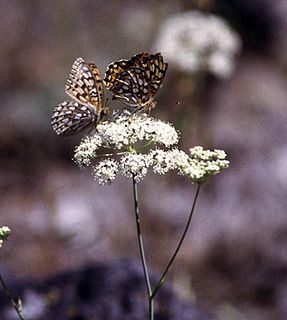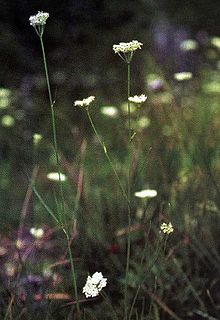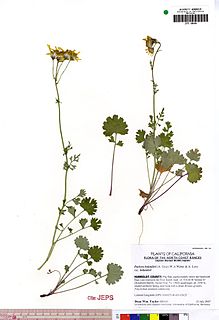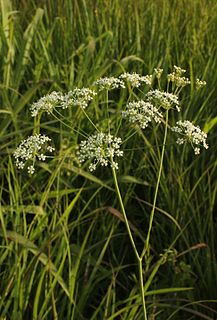Galium bolanderi is a species of flowering plant in the coffee family known by the common name Bolander's bedstraw. It is native to the mountains of California and southern Oregon. It is a resident of mountain forests and chaparral slopes.

Helianthus bolanderi is a species of sunflower known by the common names Bolander's sunflower and serpentine sunflower. It is native to California and Oregon, where it grows mainly in mountainous areas, often in serpentine soils. It has been found from southwestern Oregon as well as in northern and central California as far south as Santa Cruz County, with reports of a few isolated populations in southern California.

Astragalus bolanderi is a species of milkvetch known by the common name Bolander's milkvetch. It is native to western Nevada and parts of the Sierra Nevada in California. It grows in dry, rocky habitat on mountain and plateau.
Isoetes bolanderi, or Bolander's quillwort, is a species of quillwort, a type of lycophyte. This aquatic plant is native to high altitude regions of the western United States and southern Alberta. It grows almost entirely underwater in lakes and other water bodies from a corm-like stem, which remains buried in the mud, producing up to twenty pointed, cylindrical leaves approaching 15 centimeters in maximum length. It reproduces via spherical sporangia, covered about one third by the velum. The ligule is small and heart-shaped. The megaspores are white, though sometimes bluish, and 350 to 290 micrometers in diameter. The microspores are 25 to 30 micrometers long.

Lilium bolanderi is a rare North American species of plants in the lily family, known by the common name Bolander's lily. It is native to northwestern California and southwestern Oregon.
Lithophragma bolanderi is a species of flowering plant in the saxifrage family known by the common name Bolander's woodland star. It is endemic to California, where it is known from several mountain ranges, including the North Coast Ranges, the foothills of the Sierra Nevada, and the San Gabriel Mountains. It grows in many types of open habitat. It is a rhizomatous perennial herb growing erect or leaning with a tall naked flowering stem. The leaves are located on the lower part of the stem, each divided into rounded lobes. The stem bears up to 25 flowers, each in a cuplike calyx of red or green sepals. The five petals are white, under one centimeter long, and toothed or smooth along the edges.
Kyhosia is a monotypic genus of flowering plants in the aster family containing the single species Kyhosia bolanderi, which is known by the common names Bolander's madia and kyhosia.
Phalacroseris is a monotypic genus of flowering plants in the daisy family containing the single species Phalacroseris bolanderi, which is known by the common name Bolander's mock dandelion.
Perideridia bacigalupii is an uncommon species of flowering plant in the family Apiaceae known by the common names Mother Lode yampah and Bacigalupi's perideridia. It is endemic to California, where it is known only from the northern and central Sierra Nevada foothills. It is a member of the flora in chaparral and pine woodlands. It is a perennial herb which may exceed 1.5 meters in maximum height, its slender, erect stem growing from tubers. Leaves near the base of the plant have blades up to 40 centimeters long which are divided into many narrow subdivided lobes. Leaves higher on the plant are smaller and less divided. The inflorescence is a compound umbel of many spherical clusters of small white flowers. These yield ribbed, oblong-shaped fruits about half a centimeter long.
Perideridia californica is a species of flowering plant in the family Apiaceae known by the common name California yampah. It is endemic to California, where it is known from the Central Coast Ranges and a section of the Sierra Nevada foothills. It grows in moist soils, often near streams. It is a perennial herb which may approach 1.5 meters in maximum height, its slender, erect stem growing from cylindrical tubers measuring up to 12 centimeters long. Leaves near the base of the plant have blades up to 40 centimeters long which are divided into many flat, narrow, subdivided lobes. Leaves higher on the plant are smaller and less divided. The inflorescence is a compound umbel of many spherical clusters of small white flowers. These yield ribbed, oblong-shaped fruits under a centimeter long.
Perideridia howellii is a species of flowering plant in the family Apiaceae known by the common name Howell's yampah. It is native to the mountains of Oregon and northern California, where it grows in moist soils, often near streams and rivers. It is a perennial herb which may exceed 1.5 metres in maximum height, its slender, erect stem growing from a cluster of many narrow fibrous roots measuring up to 15 centimetres long. Leaves near the base of the plant have lance-shaped blades up to half a metre long which are divided into many leaflets made up of toothed, oval segments. Leaves higher on the plant are similar, but generally smaller. The inflorescence is a compound umbel of many spherical clusters of small white flowers. These yield ribbed, oblong-shaped fruits each about half a centimetre long.

Perideridia kelloggii is a species of flowering plant in the family Apiaceae known by the common name Kellogg's yampah. It is endemic to California, where it is known from the north and central coasts, the San Francisco Bay Area, and the Sierra Nevada foothills. It grows in grassland habitat, sometimes on serpentine soils. It is a perennial herb which may reach 1.5 meters in maximum height, its slender, erect stem growing from a cluster of long, narrow, fibrous roots each up to 15 centimeters long. Leaves near the base of the plant have blades up to 45 centimeters wide which are divided into many leaflets subdivided into narrow, elongated lobes. The inflorescence is a compound umbel of many spherical clusters of small white flowers. These yield ribbed, oblong-shaped fruits each about half a centimeter long.
Perideridia lemmonii is a species of flowering plant in the family Apiaceae known by the common names Lemmon's yampah and tuni. It is native to the western United States, where it is known from southeastern Oregon, western Nevada, and the mountains of eastern California. It grows in meadows, forests, and other habitat. It is a perennial herb approaching one meter in maximum height, its slender, erect stem growing from usually a single small tuber about 1.5 centimeters long. Leaves near the base of the plant have blades up to 30 centimeters long divided into one or two pairs of leaflets, each of which may be subdivided. The inflorescence is a compound umbel of many spherical clusters of small white flowers. These yield ribbed, round or oblong-shaped fruits each under half a centimeter long.

Perideridia oregana is a species of flowering plant in the family Apiaceae known by the common names Oregon yampah and eppaw. It is native to Oregon and California in the western United States, where it grows in woodland and other habitat. This plant is quite variable in appearance. In general, it is a perennial herb 10 to 90 centimeters tall, its green to waxy-grayish erect stem growing from a cluster of small tubers. Leaves near the base of the plant have blades 3 to 30 centimeters long divided into a variable number of leaflets, which may be subdivided into smaller segments. The inflorescence is a compound umbel of many spherical clusters of small white flowers. These yield ribbed, oblong-shaped fruits 3 to 6 millimeters long.

Perideridia parishii is a species of flowering plant in the family Apiaceae known by the common name Parish's yampah. It is native to mountainous regions of the southwestern United States, where it grows in forests and other habitat. It is a perennial herb growing up to 90 centimeters tall, its slender green stem growing from a small tuber. Leaves near the base of the plant have blades 10 to 20 centimeters long divided into pairs of leaflets, which may be subdivided or lobed. The inflorescence is a compound umbel of many spherical clusters of small white flowers. These yield ribbed, round or oblong-shaped fruits each about half a centimeter long.

Packera bolanderi is a species of flowering plant in the aster family known by the common names Bolander's ragwort and seacoast ragwort. It is native to the west coast of the United States from Washington to northern California, where it grows in wet coastal forests and woodlands. There are two varieties of the species which differ slightly in morphology and habitat occupied; these varieties have been considered separate species by some authors. The var. bolanderi has thicker leaves, occurs farther south, and occupies more open types of habitat, than does var. harfordii. This plant in general is a perennial herb producing one to three stems up to half a meter tall. The basal leaves have blades up to 12 centimeters long which are divided into several lobes and borne on long, thin petioles. Leaves growing farther up the stem are smaller and have more lobes on their blades. The inflorescence contains several flower heads, each lined with dark green phyllaries. The head contains many golden yellow disc florets and generally either 8 or 13 yellow ray florets each over a centimeter long. The fruit is an achene tipped with a pappus of bristles.
Trifolium bolanderi is a species of clover known by the common names Bolander's clover and parasol clover.
Agnorhiza bolanderi is a species of flowering plant known by the common name Bolander's mule's ears. It is endemic to California, where it is known only from a narrow section of the Sierra Nevada foothills about 275 kilometers long from Shasta County to Mariposa County. It grows in chaparral and grassland habitat, usually on serpentine soils.

Agnorhiza reticulata, known by the common name El Dorado County mule's ears, is a rare species of flowering plant found only in a small region of north-central California.

Perideridia americana is a species of flowering plant in the family Apiaceae known by the common names eastern yampah and wild dill. It has been found in 12 Midwestern United States, and is listed as threatened or endangered in at least 3 of them. In Missouri it is a conservation species of concern.









